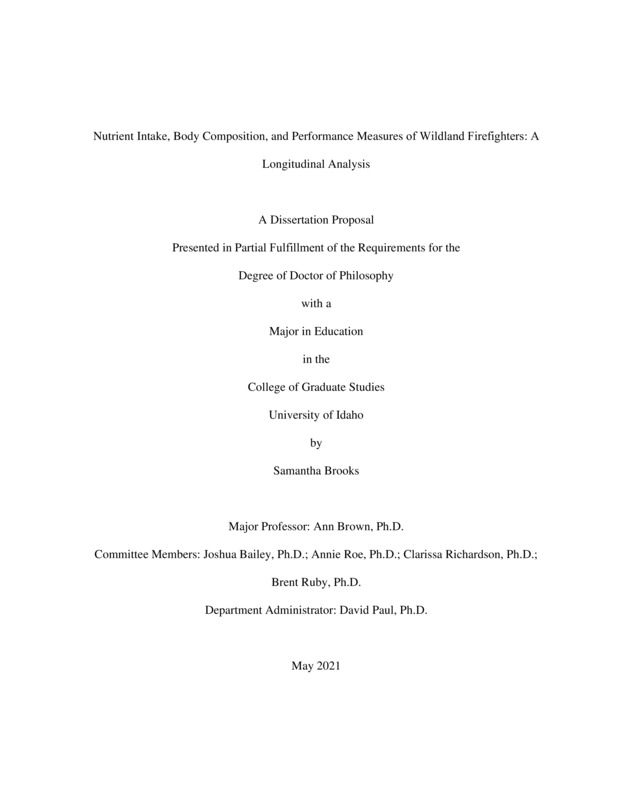Nutrient Intake, Body Composition, and Performance Measures of Wildland Firefighters: A Longitudinal Analysis
Brooks, Samantha Jo. (2021-05). Nutrient Intake, Body Composition, and Performance Measures of Wildland Firefighters: A Longitudinal Analysis. Theses and Dissertations Collection, University of Idaho Library Digital Collections. https://www.lib.uidaho.edu/digital/etd/items/brooks_idaho_0089e_12101.html
- Title:
- Nutrient Intake, Body Composition, and Performance Measures of Wildland Firefighters: A Longitudinal Analysis
- Author:
- Brooks, Samantha Jo
- Date:
- 2021-05
- Keywords:
- biomechanics nutrition physiology wildland firefighter
- Program:
- Movement & Leisure Sciences
- Subject Category:
- Physiology; Nutrition
- Abstract:
-
Background: WLFFs are tasked with performing arduous work in an unstable and adverse occupational environment causing them to make rapid adjustments to meet their energy intake needs during 14-21 days of constant wildfire suppression. The wildfire season (typically June-September) provides a unique environment in which nutrient intake, body composition, and performance may be altered. Therefore, the purpose of this longitudinal study was to examine differences in nutrient intake, body composition, performance measures, and biomechanics characteristics among WLFFs pre-season, post-season, and in the off-season. Methods: WLFFs (N=18) participated in laboratory testing at the Human Performance Lab at the University of Idaho at 3-time points: Visit 1 in June (Pre: pre-season), Visit 2 in October (Post: post-season), Visit 3 in February (Off: off-season). Laboratory testing included anthropometric measures, a dual energy x-ray absorptiometry scan, muscular strength and endurance testing, biomechanics testing, and the Diet History Questionnaire completion. Participants were asked to arrive to the HPL between the hours of 0800-1200, abstaining from exercise, caffeine and/or alcohol use, and nutritional supplements for 24 hours prior to their testing appointment. Body composition was measured using dual x-ray absorptiometry (DXA; Hologic Inc., Horizon W QDR Series, Bedford, MA, USA). Performance testing included a series of muscular strength and endurance measures including a load-carriage treadmill test, shoulder and knee sagittal plane isokinetic testing, and a kettlebell handgrip test. Upon completion of performance testing, participants completed the Diet History Questionnaire III (DHQ-III). Descriptive statistics were analyzed using the Statistical Package for Social Sciences 24 (SPSS v. 24). Participants’ nutrient intake (macronutrients and micronutrients), body composition (LM, FM, ASMI, BMD, VAT), anthropometrics, shoulder and knee sagittal plane isokinetic measures (initial peak torque, fatigue index, average power), and biomechanics characteristics (mean and peak trunk inclination, stride length, stride frequency) were analyzed using a one-way repeated measures Analysis of Variance (ANOVA) to determine differences pre-season, post-season, and in the off-season. Multiple comparisons were computed with post hoc Bonferroni tests. Results: Participants included male (n=16; 89%) and female (n=2; 11%) WLFFs who spent an average of 32±21 days on wildfire assignments throughout the 2019 fire season. Twelve participants were unable to complete visit 3 due to crew dispersion (n=5), leaving the occupation (n=2), and proximity to the laboratory (n=5). A significant difference was observed for calories (kcal; p=0.014), fat (kcal; p=0.008), protein (g/kg; p=0.037) and carbohydrate (g; p=0.001, g/kg; p<0.001, kcal; p=0.001, %; p=0.003) between pre-season and off-season. Additionally, a significant difference in Sodium (p=0.020) and Vitamin B3 (mg; p=0.032) was observed between pre-season and off-season. No significant differences were observed for body composition measures, muscular strength and endurance measures, or biomechanics characteristics by visit (p>0.05). Conclusion: WLFFs macronutrient intakes and select micronutrient intakes were significantly different pre-season, and in the off-season, however no differences in body composition, performance measures, or biomechanics characteristics were observed. These data suggest WLFFs appear to maintain consistent body composition and muscular strength and endurance across the season and into the off season despite significant changes in self-selected dietary intake.
- Description:
- doctoral, D.Ed., Movement & Leisure Sciences -- University of Idaho - College of Graduate Studies, 2021-05
- Major Professor:
- Brown, Ann F.
- Committee:
- Bailey, Joshua; Roe, Annie; Richardson, Clarissa; Ruby, Brent
- Defense Date:
- 2021-05
- Identifier:
- Brooks_idaho_0089E_12101
- Type:
- Text
- Format Original:
- Format:
- application/pdf
- Rights:
- In Copyright - Educational Use Permitted. For more information, please contact University of Idaho Library Special Collections and Archives Department at libspec@uidaho.edu.
- Standardized Rights:
- http://rightsstatements.org/vocab/InC-EDU/1.0/

